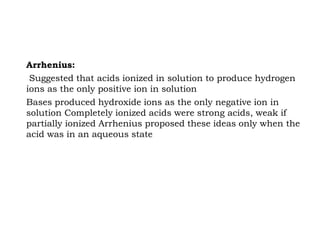The document discusses various topics related to acids and bases:
1. It defines acids and bases, and classifies common substances as acidic, basic, or neutral based on their hydrogen ion concentration in water. Examples of strong acids and bases are provided.
2. Indicators and their uses are described, including litmus, phenolphthalein, methyl orange, and bromothymol blue. Everyday uses include testing soil pH and swimming pool chemistry.
3. Acidic oxides such as SO2, SO3, and CO2 are identified, and their position in the periodic table is linked to their acidity. Most transition metal oxides are basic.
























![Identify pH as - log10 (H+) and explain that
a change in pH of 1 means a ten-fold
change in (H+)
• pH is a measure of the concentration of hydrogen ion, hence:
pH=-log10 [H + ]
• By definition, [H +][OH -] =10^-14 ie. pH +pOH =14
• [H3O+]=10^-pH . So if pH = 7, then the concentration of
H3O+= 10^-7 mol/L (neutral)
• A neutral substance is one where [H+]= [0H-] = 1x10-7molL-1
• A change in pH of 1 means a ten-fold change in [H+]. This
means that a solution of pH 1 has 10 times the concentration
of [H+] in pH 2 and 100 times the concentration in pH 3. The
pH scale is a logarithmic scale,](https://image.slidesharecdn.com/pptfinal-theacidicenvironmentnidhi-150805204556-lva1-app6892/85/The-Acidic-Environment-25-320.jpg)











